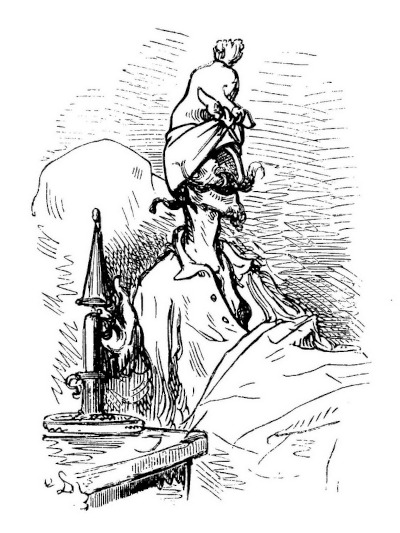Baron von Münchhausen was a fictional character created in the late 18th century who would also later appear within the career of French illustrator, Gustave Doré. The inspiration for the character is believed to have been Hieronymus Karl Friedrich, Freiherr von Münchhausen.
It was in 1785 that German author Rudolf Erich Raspe would release his novel titled, Baron Munchausen's Narrative of his Marvellous Travels and Campaigns in Russia. His trials and tribulations would also inspire a film as recently as 1985 and there have also been a number of stage productions based on the original novel from the late 18th century. Doré's own contributions would come about in 1862, at the start of a particularly busy and memorable decade for the respected illustrator who was starting to build a strong reputation within Western Europe. Aventures du Baron de Münchausen, traduction nouvelle par Théophile Gautier fils was produced in a single volume and included a large number of amusing cartoons. Doré himself had quite a strong sense of humour and so this project would have appealed to him. He would also create a number of caricatures elsewhere in his career and some of these items are perhaps worthy of greater attention within his overall output.
The drawing in front of us here captures Baron von Münchhausen in his bed, with a night hat dropping over his eyes. His nose is exceptionally prominent, as is his finely tuned moustache which pricks outwards. His bedsheet covers just above his waist and he wears clothing typical of the period. A small light sits by his side on a table and a fluffy pillow attempts to keep him comfortable. The illustrator captures much of the scene with minimal detail, able to create much with just a few lines. He creates a feeling of darkness and shadow by being more intense with his work just behind the baron, and also around his right arm. There is less of a technical brilliance to these cartoons than with his more complex illustrations found elsewhere, but one cannot avoid being amused by the playful nature of these drawings which help to bring the original text to life. He is believed to have produced over 150 drawings for this particular commission which were later published by Charles Furne in France.
Gustave Doré would become known as perhaps the finest book illustrator in European history. He was well paid for his commissions once his reputation had been established and he never found it difficult to bring new work into his studio. Eventually he would actually have the opposite problem, in delivering these requests in a timely manner and so chose to expand his studio to include a large number of assistants who held a variety of specialist skills. Engravers would help him to just focus on his drawings and he would also later experiment successfully as a painter. He was just as curious as he was talented, though illustration was always at the heart of his career, having shown initial promise within this medium as a child. As level of literacy were also starting to rise across Western Europe, so publishers needed to offer the best publications that they could in order to take advantage of this growing market.




